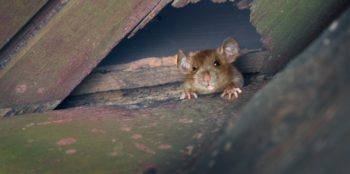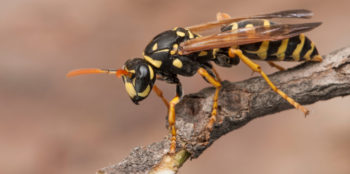
Black widow spiders are probably the scariest pest living in Michigan. They’re surprisingly common, highly venomous, and they’ll live anywhere they want. We understand freaking about them a little, especially if you just learned they’re here. Where life finds a way to create something terrifying like the black widow, however, life also finds a way to balance it out.
That’s where the blue mud wasp comes in. Believe it or not, blue mud wasps hunt and eat black widow spiders. A lot. In fact, they’re considered one of the black widow’s primary predators. And they’re just as if not more common than the black widows here in Michigan! Here’s the lowdown on blue mud wasps, including how they hunt black widows and why.

What is a blue mud wasp?
The blue mud wasp (Chalybion californicum) or “blue mud dauber” is a species of mud dauber wasps. “Mud dauber” is the common name for species of wasps in the families Sphecidae or Crabronidae. The name references the fact that the wasps build their small nests in mud. The blue mud wasps’ name references its bodies’ distinctive, metallic blue-black sheen. Male blue mud wasps are around ⅜ to ½ inches long; females are between ¾ to ⅞ inches long.
Like other mud daubers, blue mud wasps are solitary wasps. They actually steal their mud nests from other mud dauber species such as Sceliphron camentarium. After replacing Sceliphron camentarium larvae in the nest with their own, blue mud wasps tend to their larvae themselves. Blue wasp larvae resemble most maggots: they’re around an inch long, cream-colored, legless, and defenseless. Adult wasps tend to the maggots by dropping food into the nest continuously.

Does a blue mud wasp really kill black widows?
To feed their offspring, adult blue mud wasps need to keep finding and bringing food back to the nest. Well, believe it or not, the food blue mud wasps bring back to their young… is usually black widows! Adult blue mud wasps continuously hunt down, paralyze, and carry black widows back to their offspring. The wasp uses a specialized stinger to immobilize the black widow, rendering it defenseless so larvae can eat it.
Blue mud wasps follow a very clever routine to capture their prey. First, they seek out and tap on a black widow’s spider web. Feeling the vibrations of would-be prey, the black widow comes out–and the blue mud wasp strikes! Blue mud wasps will actually “stock” their nests with paralyzed spiders, even before they produce offspring. Blue mud wasps also target other species of spider, but they’re considered one of the primary predators of black widows.

Where do blue mud wasps live?
The blue mud wasp is common throughout North America, from southern Canada to northern Mexico. They’re particularly common in Michigan. Blue mud wasps can and do live in a wide variety of environments. They’re particularly common near sources of water (and therefore mud). Many blue mud wasps also build nests in areas where they can easily capture prey for their offspring. Adult blue mud wasps actually feed on flower nectar, not spiders, so they may also frequent gardens.
Because blue mud wasps steal nests instead of making their own, they tend to live where other dauber species do. Other daubers build nests by collecting mud and rolling it into balls and arranging it with their mandibles. They’ll also build paralyzed spiders into these nests by constructing mud “cells” around them. They may roll or carry this mud near homes. Nests look like circular or oval-shaped mud balls. You may also notice exit holes where fully grown wasps emerged.

Are blue mud wasps dangerous?
No. Blue mud wasps and other mud daubers are considerably less aggressive than other wasp families. Unlike social wasps, daubers will not aggressively defend their nest of their territory. Even if you accidentally find a dauber’s nest, it’s possible the adult won’t attack you to drive you away. Blue mud wasps can potentially sting humans, but it’s very, very rare. The only time a blue mud wasp might sting you is if you mishandle or antagonize it.
Blue mud wasps are usually pretty easy to spot, even from a distance. Look for an iridescent blue shine, often on or near flowers. The dauber’s blue sheen frequently catches the light. You could also look for their nests, which could be either on the ground or affixed to a wall. Nests may be somewhat difficult to find, especially if they’re new or particularly small. Wasps rarely build nests out in the open. You’re more likely to find them on, near, or under a form of cover.
Nature is a system of checks and balances–even where the black widow is concerned. Just because venomous spiders may scare us half to death doesn’t mean they get to break the rules. There’s something oddly comforting about the notion that even black widows have something to watch out for.
That being said, you can’t exactly rely on the blue mud wasp. It’s just doing its own thing after all; it’s not watching out for you. If you have a spider (or wasp!) concern, depend on Griffin instead. We have the solution to your problem.





